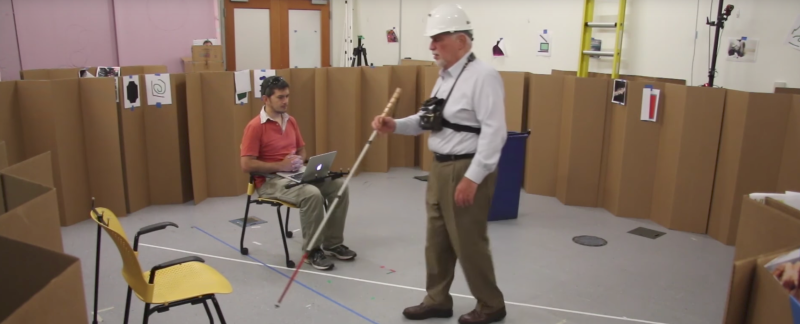This interesting project out of MIT aims to use technology to help visually impaired people navigate through the use of a haptic feedback belt, chest-mounted sensors, and a braille display.
The belt consists of a vibration motors controlled by what appears to be a Raspberry Pi (for the prototype anyway) with a distance sensor and camera connected as well. The core algorithm is designed to take input from the camera and distance sensors to compute the distance to obstacles, and to buzz the right motor to alert the user — fairly expected stuff. However, the project has a higher goal: to assist in identifying and using chairs.
Aiming to detect the seat and arms, the algorithm looks for three horizontal surfaces near each other, taking extra care to ensure the chair isn’t occupied. The study found that, used in conjunction with a cane, the system noticeably helped users navigate through realistic environments, as measured by minor and major collisions. Users recorded dramatically fewer collisions as compared to using the system alone or the cane alone. The project also calls for a belt-mounted braille display to relay more complicated information to the user.
We at HaD have followed along with several braille projects, including a refreshable braille display, a computer with a braille display and keyboard, and this braille printer.
[via MIT News]

















Very interesting approach. I was always wondering why we didn’t see more (no pun intended) use of “haptic feedback” as assistent systems for the visually impaired. I guess it’s mainly because you have to limit the amount of information to specific tasks – like finding a vacant chair – in order to really help (as opposed to flooding with information) the user.
Having to point the whole body into the direction you want the camera to peer seems unnecessary, though. The user’s head seems more suited for that, so mounting a (light weight) camera rig on the helmet makes more sense to me.
Passive vs. active. Chairs vs. activity. Not the right way to health. We and the blind have enough health problems without more encouragement to inactivity. I have no problem standing up. Braille is like old school serial ports, good for text. Even the blind can be given a multidimensional world now. For longer than Google glass I have been wearing on my glasses a rear-vue mirror. I can make confident left turns on a bike in traffic without doing head yoga. Iff that scanner can find a seat on a subway in New York, good luck.
Not everyone has two good knees. Keep riding that bike in traffic and you are liable to end up driving a wheelchair. In the mean time, you’ll wear out everything from the waist down, then you’ll understand why sitting down is a good thing.
Ha ha. Just about every study on risk -vs- benefit of urban cycling disagrees with you.
Hi, each time that HaD posts an article about Braille and they mention previous works published here, my project MOLBED (https://hackaday.io/project/12442-molbed-modular-low-cost-braille-electronic-display) is never mentioned. Everytime this leaves me a little bit disappointed because my project, among the others you mention, is up to now the only showing a real, working prototype, and is also shared as fully open source, and was one of the 20 selected project in last year’s Hackaday prize, assistive technology.
If you talked with people with visual impairments who use a cane, you’d find that they love their canes as they are the ultimate “haptic feedback” devices. This project strikes me as a well meaning but misguided. Keep in mind that most “blind” people have some amount of vision. So any aid needs to be an augmentation tailored to the individual and how they’ve adapted to their impairment. Cane training accomplishes this quite well.
The fact that this does not immediately improve the life of every blind person does not make this project “misguided”. For the on part, they seem to have talked to blind people. For the other part, having an AI to assist you might be a better choice in the future than Blind Dogs, which are still often used. People always want to see finished products, instead of encouraging slight improvements.
Couldn’t agree more! I’m blind. And for no misunderstanding: I’m agreeing to the last comment of developer which I greatly encourage to proceed!